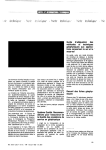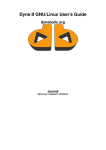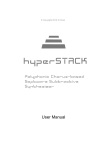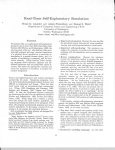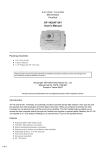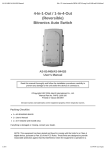Download XSPIF: User Guide
Transcript
XSPIF: User Guide
a cross standards plugin framework
—
IRCAM – Centre Georges Pompidou
Vincent Goudard and Remy Muller
September 8, 2003
Contents
1 Introduction
1
2 System requirement - Prerequisites
2.1 What you should know . . . . . . .
2.2 Python . . . . . . . . . . . . . . . .
2.3 PyXML 0.8.2 or above . . . . . . .
2.4 Compiler/IDE and SDK . . . . . .
2.4.1 Compiler/IDE . . . . . . . .
2.4.2 SDKs . . . . . . . . . . . .
.
.
.
.
.
.
2
2
2
2
3
3
3
3 From the model to the XML description
3.1 The model . . . . . . . . . . . . . . . . . . . . . . . . . . . . . . .
3.2 Document Type Definition . . . . . . . . . . . . . . . . . . . . . .
3.3 XML syntax . . . . . . . . . . . . . . . . . . . . . . . . . . . . . .
4
4
5
5
4 XSPIF Tutorial
4.1 Writing a XSPIF meta-plugin
4.1.1 The header . . . . . .
4.1.2 < plugin > . . . . . .
4.1.3 < pin > . . . . . . . .
4.1.4 < param > . . . . . .
4.1.5 < state > . . . . . . .
4.1.6 < controlout > . . . .
4.1.7 < callback > . . . . .
4.1.8 XSPIF API . . . . . .
4.1.9 C vs C++ . . . . . . .
4.2 Code generation . . . . . . . .
4.3 Compilation and integration .
4.3.1 Windows . . . . . . . .
4.3.2 Linux . . . . . . . . .
4.3.3 Mac OSX . . . . . . .
.
.
.
.
.
.
.
.
.
.
.
.
.
.
.
.
.
.
.
.
.
.
.
.
.
.
.
.
.
.
.
.
.
.
.
.
.
.
.
.
.
.
.
.
.
.
.
.
.
.
.
.
.
.
.
.
.
.
.
.
.
.
.
.
.
.
.
.
.
.
.
.
.
.
.
.
.
.
.
.
.
.
.
.
.
.
.
.
.
.
.
.
.
.
.
.
.
.
.
.
.
.
.
.
.
.
.
.
.
.
.
.
.
.
.
.
.
.
.
.
.
.
.
.
.
.
.
.
.
.
.
.
.
.
.
.
.
.
.
.
.
.
.
.
.
.
.
.
.
.
.
.
.
.
.
.
.
.
.
.
.
.
.
.
.
.
.
.
.
.
.
.
.
.
.
.
.
.
.
.
.
.
.
.
.
.
.
.
.
.
.
.
.
.
.
.
.
.
.
.
.
.
.
.
.
.
.
.
.
.
.
.
.
.
.
.
.
.
.
.
.
.
.
.
.
.
.
.
.
.
.
.
.
.
.
.
.
.
.
.
.
.
.
.
.
.
.
.
.
.
.
.
.
.
.
.
.
.
.
.
.
.
.
.
.
.
.
.
.
.
.
.
.
.
.
.
.
.
.
.
.
.
.
.
.
.
.
.
.
.
.
.
.
.
.
.
.
.
.
.
.
.
.
.
.
.
.
.
.
.
.
.
.
.
.
.
.
.
.
.
.
.
.
.
.
.
.
.
.
.
.
.
.
.
.
.
.
.
.
.
.
.
.
.
.
.
.
.
.
.
.
.
.
.
.
.
.
.
.
.
.
.
.
.
.
.
.
.
.
.
.
.
.
.
.
.
.
.
.
.
.
.
.
.
.
.
.
.
.
.
.
.
.
.
.
.
7
7
7
7
9
10
11
11
12
14
14
15
15
15
15
16
CONTENTS
5 Standards specific considerations
5.1 VST . . . . . . . . . . . . . . .
5.2 Audio Units . . . . . . . . . . .
5.3 LADSPA . . . . . . . . . . . . .
5.4 PureData, Max/Msp, jMax . .
Bibliography
2
.
.
.
.
.
.
.
.
.
.
.
.
.
.
.
.
.
.
.
.
.
.
.
.
.
.
.
.
.
.
.
.
.
.
.
.
.
.
.
.
.
.
.
.
.
.
.
.
.
.
.
.
.
.
.
.
.
.
.
.
.
.
.
.
.
.
.
.
.
.
.
.
.
.
.
.
17
17
17
17
18
19
Abstract
XSPIF is a framework dedicated to help developing cross-plateforms and crossstandards audio plugins. It consists in describing the plugin’s behaviour – i.e. its
actions and its state(s) – and its interface (i.e. its controllable parameters and
its audio ports) in a XML file (.xspif) and then use PYTHON a python script
to generate the C or C++ source-code for each supported “standard” – i.e. for
now: VST, AudioUnit,LADSPA, Max/Msp, jMax and Pure Data –.
Chapter 1
Introduction
From the XSPIF point of view, a plugin is Digital Signal Processing module aimed
to be integrated inside a host application within a network, a graph or a chain
of other modules. Its “interface” is fully defined by its audio input and output
ports (also called pins), its controllable parameters and its control output(s) –
when control data is derived from the audio stream –.
Therefore, plugins generated with XSPIF are mainly meant for doing effects,
analysis or “continuous synthesis” – i.e. as the notion of events is not modelized
yet, MIDI synthetizers are not handled –.
Furthermore, XSPIF relies on the availability of a generic Graphical User Interface generated automatically by the host application as a remote for the plugin.
So what should you use XSPIF for?
XSPIF lets you develop plugins for multiple standards from the same code.
XSPIF can generate plugin templates from the definition of its “interface”.
XSPIF is a fast way to prototype and test new algorithms.
XSPIF can help you starting a new project by generating the skeleton of your
plugin and then let you cutomize it to your needs.
In this manual, you should find all the information or the pointers you would
need to quickly start doing plugins with XSPIF. There is brief description of the
“technologies” involved in XSPIF – i.e. XML and PYTHON – and the links to
the necessary downloads, followed by a tutorial showing you how to write your
first XSPIF plugin, generate the sources and compile them.
There are 6 supported standards – VST, AudioUnits, LADSPA and Max/MSP,
PureData and jMax – but others are planned to be added. If you want collaborate to XSPIF by adding a format or a new feature, please refer to the “XSPIF:
developper guide” [GM03a] and if you want to have an overview of the existing plugin standards and their specificities refer to “Audio plugin architectures”
[GM03b].
Chapter 2
System requirement Prerequisites
2.1
What you should know
To fully understand how to use XSPIF, it is necessary to have a general understanding of programming techniques, especially in C and of real-time constraints.
However, XSPIF has been designed in order to make it the simplest possible to
develop audio plugins.
If you want to develop audio plugins, it is also useful to have basic knowledge in
signal processing. There are a number of websites, where you can find information, and sample code to start with. http://www.musicdsp.org.
2.2
Python
First of all, XSPIF needs python 2.2 or above to be installed on your machine.
Usually it is installed by default on recent linux distributions. For windows, there
is an installer available at: http://www.python.org/download/ and for Mac
OSX we recommand to install python through Fink (http://fink.sourceforge.net/)
and FinkCommmander (a front-end for apt-get, similar to synaptic on linux) until there is a real installer of PyXML for OSX. For more explanation refer to
[vRc03].
2.3
PyXML 0.8.2 or above
You will also need PyXML 0.8.2 or above. It is a python package dedicated
to XML handling. You can find it at http://pyxml.sourceforge.net/. For
Mac OSX we highly recommend to install it through FinkCommander which will
2.4 Compiler/IDE and SDK
3
automatically check all the dependencies and show if a new version is available.
For Windows, there is also an installer available in the downloads page.
For more explanation refer to [Kc03].
2.4
2.4.1
Compiler/IDE and SDK
Compiler/IDE
• OSX: Our reference IDE is Project Builder which uses gcc for mac and is
easy to use and to customize to run XSPIF to generate new sources before
rebuilding the plugin.
• Win: Although some people have succeed in building VST plugins with
MingW Dev C++ or Borland C++ Builder. We only provide examples
for Visual C++ as the vstsdk is primarily designed to be used with Visual
C++.
• Linux: The reference compiler we have used is gcc
2.4.2
SDKs
• VST Available on Steinberg’s web site http://ygrabit.steinberg.de/
users/ygrabit/public_html/vstsdk/OnlineDoc/vstsdk2.3/index.html1
• AU Available on Apple’s site http://developer.apple.com/audio/
• LADSPA Available on the LADSPA web site http://www.ladspa.org.2
• PD Available on PureData’s web site http://www.puredata.org.
• Max/Msp Available on Cycling 74’s web site http://www.cycling74.
com/products/dldoc.html.
• jMax The jMax distribution including all the source-code is available on
Ircam’s freesoftware web-site http://freesoftware.ircam.fr/.
1
2
[Gc03] and [Gra03]
[Dev03]
Chapter 3
From the model to the XML
description
3.1
The model
Here is a simple model behind audio plugins architecture. A plugin can be viewed
as a kind of black box, which gets audio buffer(s) and control value(s) as inputs,
and outputs transformed audio buffer, and control values.
Figure 3.1: XSPIF model behind audio plugins
However, as long as our plugin remains a model, it will not do much.
3.2 Document Type Definition
5
In order to perform its job, this box needs to be instanciated. Instanciation
consists in allocating the memory needed by the plugin and its variables.
Then it needs to be activated, i.e. perform and compute everything that is needed,
so that the plugin is ready to perform some DSP processing.
If we want to stop processing audio for a while, we can deactivate the plugin, just
like we would do with an on/off (or bypass) switch for a machine.
Now, when we no longer want to use this plugin, we have to deinstantiate to free
the memory location used by the plugin, and by the structure it needs.
To sum up what is said above, we’ve introduced the following callbacks (i.e. the
methods of the plugin that you can implement.):
• instantiate: the constructor.
• deinstantiate: the destructor.
• activate: plugin ON.
• deactivate plugin OFF (bypass).
• process where the DSP algorithm is implemented.
3.2
Document Type Definition
This very raw and simple model led us to a XML meta-plugin description with
various elements. The Document Type Definition xspif.dtd is a file describing
the way a meta-plugin should be written.
More precisely it defines what the possible or required elements are, where they
are, how many of them one can find in the meta-plugin, what are their attributes
and sub-elements and what value they can take.
The user can refer to this file to get a quick overview of the meta-plugin syntax.
Otherwise refer to the next section 4 which will explain in details all the elements
you can use and their respective roles.
3.3
XML syntax
XML1 [Wal98] is language to describe documents containing structured information. The information in embedded in elements defined by an opening and a
closing tag:
< myElement > ...inf ormation... < /myElement >
These elements can have child elements, as well as attributes – some information
specific to the element – The various elements used in XSPIF are listed below,
and further described in the next chapter:
1
XML: eXtended Markup Language
3.3 XML syntax
Elements
< plugin(attributes) >< /plugin >
< pin(attributes) >< /pin >
< param(attributes >< /param >
< state(attributes) >< /states >
< controlout(attributes) >< /controlout >
< caption >< /callback >
< comment >< /callback >
< code >< /callback >
6
Signification
Main element
Audio input or output
Controllable parameter
Internal state
Control output
Caption of the parent element
Comment for the parent element
Code for the parent element
Chapter 4
XSPIF Tutorial
4.1
Writing a XSPIF meta-plugin
A meta-plugin is a XML file beginning with a header specifying its syntax and
followed by the various elements described in the last section organized in an
arborescent structure whose root is < plugin >
This chapter will explain how to write the meta-plugin with detailed information
on each specific elements, their hierarchy and examples of implementation.
4.1.1
The header
Each XSPIF meta-plugin description has to begin with the following header:
<?xml version="1.0"?>
<!DOCTYPE plugin SYSTEM "xspif.dtd">
The first line specifies which version of XML is used and the second line informs
the parser where to find the the Document Type Definition (i.e. the syntaxic
rules telling how a xspif file has to be written to be correct from the XML point
of view).
4.1.2
< plugin >
This is the main tag which is the unique root of the tree.
• Attributes:
label It will be used to name the plugin class or structure and shouldn’t
have spaces in it.
plugId It should be either a four character constant into simple quotes, or
an 32-bit unsigned integer identifying the plugin. It should be unique.
4.1 Writing a XSPIF meta-plugin
8
manuf Id another ID to be sure that the plugin can be uniquely identified.
maker [optionnal] a string describing the plugin maker
copyright [optionnal] a string to specify the copyright if needed. It will be
used into the generated sources.
• Elements:
< caption > [optionnal] A string describing the plugin
< comment > [optionnal] a tag to add global comments to your code
< code > [optionnal] you can declare local variables, macros, functions and
additionnals includes segments on top of your file which has to be
inside a <![CDATA[...]]> tag so that your code is not analyzed by
the parser and can be pasted directly into your generated source file(s)
“as-is”.
< pin > [1 or more] A pin is a port through which the audio signal flows.
A pin is either input or output and can be multi-channels. see below
4.1.3
< param > [0 or more] A param is a port for the control input, available
to the plugin user and to the host. see below 4.1.4
< controlout > [0 or more] A controlout is a port for outputting control
back to the host or to other plugins when possible. see below 4.1.6
< state > [0 or more] A state is keeping an internal information necessary
for the behaviour of the plugin, but not available to the plugin user.
see below 4.1.5
< callback > [0 or more] There is a finite number of callbacks, which implement the behaviour of the plugin, namely: instantiate, deinstantiate,
activate, deactivate, and process. see below 4.1.7
• Example:
This example defines a plugin (the root element of the XML tree) whose
label is LowPass with the plugin ID ’lowp’ and the manufacturer ID ReMu.
There are additionnal information about the maker which is r´emy muller
and the copyright which is GPL. this plugin contains a caption Lowpass
intented to be a human-readable name, some comments to describe the
plugin and a piece of code which includes an additionnal header and defines
a local function which will be used during by the DSP algorithm. Note that
the < plugin > tag is not closed because it will also contain child elements.
<plugin
label = "LowPass" plugId="’lowp’" manufId="’ReMu’"
maker="Remy Muller" copyright="GPL">
4.1 Writing a XSPIF meta-plugin
9
<caption>Lowpass</caption>
<comment>A simple lowpass with saturation</comment>
<code><![CDATA[
#include <math.h>
/******************************************/
/* independent code here */
static float saturate(float x)
{
if(x>0.f)
x = 2.f*x-x*x;
else
x= 2.f*x + x*x;
return x;
}
/******************************************/
]]></code>
</plugin>
4.1.3
< pin >
Audio Ports are declared as pins, which means that a single stereo input is represented by 1 pin with 2 channels and direction = In.
• Attributes:
label It will be used to name the audio buffers associated to the pin inside
the DSP algorithm.
dir It tells if the pin is an input or an output.
channels It specifies the number of channels inside the pin.
• Elements:
< caption > [optionnal] the friendly name of the pin.
< comment > [optionnal] some comments about the pin.
• Example:
Here we define a stereo audio pin which direction is an input, its label is
input which means that the input buffers will be known as input1[] and
input2[]. There is also a caption which can be used to show the pins name
to the final user and some comment to document the code.
<pin label="input" dir="In" channels="2">
<caption>Stereo Input</caption>
<comment>This is a stereo input pin</comment>
</pin>
4.1 Writing a XSPIF meta-plugin
4.1.4
10
< param >
The parameters are the plugin variables that the user can control. They can be
used either directly inside the process or converted into internal states.
• Attributes:
label It will be used to name the parameter. Its value is stored inside the
plugin class or structure and is always available when calling it directly
by the label.
min It specifies the minimum value that the parameter can take and should
be less than max and default.
max It specifies the maximum value that the parameter can take and
should be strictly superior than min and default.
def ault It specifies the default value that the parameter can take and
should be in the range [min; max]
type can be float or int.
mapping can be lin for linear or log for logarithmic. Default is linear.
unit [optionnal] a string for GUI display.
noinlet [optionnal] can be “true” or “false”, default is “false”. It is only
used in modular hosts so that not all parameters appear as an input.
• Elements:
< caption > [optionnal] the friendly name of the parameter.
< comment > [optionnal] some comment about this parameter.
< code > [optionnal] each parameter change can trigger a piece of code to
update the plugin’s states, or ouptput a control value for example. cf.
4.1.2
• Example:
Here we define a cutoff parameter for a filter, in the range [100, 10000] Herz,
with a default value of 1000 Hz. It has a logarithmic mapping, because it
is more convenient for a frequency. This parametere has an associated
piece of code which is triggered when the parameter changes to actualize
the internal state lambda. We can also note that in this computation, the
parameter is directly known from its label (cutoff) and that it also requires
the samplerate which is accessed with a macro defined in the XSPIF API.
<param label="cutoff" min="100.0" max="10000.0" default="1000.0"
type="float" mapping="log" unit="Hz">
<caption>Cutoff frequency (Hz)</caption>
4.1 Writing a XSPIF meta-plugin
11
<code><![CDATA[
// cutoff and samplerate are both in Hertz
lambda = exp(- cutoff / XSPIF_GET_SAMPLE_RATE());
]]></code>
<comment>This is the cutoff frequency of the plugin</comment>
</param>
4.1.5
< state >
The states are all the variables stored inside the plugin, different from the parameters and that are necessary for the DSP algorithm – e.g. you can map cutoff
and resonance parameters to internal filter coefficients – . Note that, as states
can be of any type and to be compatible with both C and C++, they should be
manually allocated with malloc() (or calloc()) and freed with free().
• Attributes:
label It will be used to name the state. Their value is stored inside the
plugin class or structure and are always available when calling them
directly by their label.
type type can be anything either buit-in types or user defined.
• Example of two internal states; one of type float, and a pointer to a buffer
of floats:
<state type="float" label="lambda"></state>
<state type="float *" label="buffer"></state>
4.1.6
< controlout >
• Attributes:
label It will be used as a selector used when sending control outside of the
plugin.
min It specifies the minimum value that the parameter can take and should
be less than max and default.
max It specifies the maximum value that the parameter can take and
should be strictly superior than min and default.
type can be float or int
mapping [optionnal] can be lin for linear or log for logarithmic. Default is
linear.
4.1 Writing a XSPIF meta-plugin
12
• Elements:
< caption > [optionnal] cf. 4.1.2
< comment > [optionnal] cf. 4.1.2
• Example:
A controlout called env for outputting the enveloppe of an audio signal, the
min, max and mapping are used when this is necessary to scale the value to
put it into a specific range (e.g. 0-127 for MIDI CC or 0-1 for normalized
parameters. . . )
<controlout label="env" min="0.0" max="10000.0" type="float" mapping="log">
<caption>Enveloppe</caption>
<comment>Peak amplitude envelope</comment>
</controlout>
4.1.7
< callback >
The callbacks are not mandatory, so that one can generate templates. On the
other side, having the same callback twice or more isn’t allowed as it wouldn’t
be meaningful.
instantiate is the callback where the user should implement the memory allocation of all structures he will need with malloc or calloc. Initialization
of the states can also be done here.
deinstantiate is the callback where the user should free the memory allocated
for the structures in instantiate with free.
activate is called every time the plugin user of host switch on the plugin. The
states can be reinitialized if needed (for example, by clearing a buffer used
in a delay, so that the delay does not ring again when the plugin is reactivated). The parameters should not usually not be reinitialized, though
this is not forbidden. If a structure depends on the sample rate (e.g. a
delay buffer), it can be the right place to check if it has changed, and in
this case, reallocate the memory for this structure.
deactivate is called every time the plugin user of host switch off the plugin.
The states can be reinitialized if needed. The parameters should usually
not be reinitialized, though this is not forbidden.
process is the callback where the user should implement the DSP algorithm.
• Attributes:
4.1 Writing a XSPIF meta-plugin
13
< label > the label can be any of instantiate (constructor), deinstantiate
(destructor), activate (on), deactivate (off), process.
• Elements:
< code > [optionnal] The code which will be associated to the callback
defined by label. cf. 4.1.2
• Examples:
Here we define the process callback which, as all the callback, only contains
a piece of code. Note that there are 2 macros from the XSPIF API that
are used in this example: XSP IF GET V ECT OR SIZE() to know the
size of the current buffer and XSP IF W RIT E SAM P LE() to write the
processed samples to the the output buffers.
<callback label="process">
<code><![CDATA[
int i = 0;
for(i=0;i < XSPIF_GET_VECTOR_SIZE();i++)
{
// in and out names are derived from the label in the pin declaration
lp1 = (1.f-lambda)*input1[i] + lambda*lp1;
lp2 = (1.f-lambda)*input2[i] + lambda*lp2;
XSPIF_WRITE_SAMPLE(output1, i, saturate(lp1));
XSPIF_WRITE_SAMPLE(output2, i, saturate(lp2));
}
]]></code>
</callback>
<callback label="instantiate">
<code><![CDATA[
// Initialize the internal states
lambda = lp1 = lp2 = 0.;
]]></code>
</callback>
<callback label="deactivate">
<code><![CDATA[
// clears memories so that no sound is output
// when plugin is reactivated with no input
lp1 = lp2 = 0.;
]]></code>
</callback>
4.1 Writing a XSPIF meta-plugin
4.1.8
14
XSPIF API
XSPIF API is quite simple and is limited to a few macros required to have a full
abstraction from the plugin standards behind XSPIF. Their meaning is explained
here after, as well as the part of the code in which they are allowed. None of these
macros are available in the code elements associated to the < plugin > element
• XSP IF W RIT E SAM P LE(dest, index, value):
It handles automatically adding or replacing process according to the standard.
Availability: process callback only.
dest has to be a pointer on a float array.
index is the index in this array.
value is the value to be written to the array.
• XSP IF CON T ROLOU T (label, index, value):
It handles control outputs, with sample accuracy in the process callback.
Availability: process callback and parameters’ attached code.
label is the label given in the corresponding controlout tag and is used as
selector for sending control.
index if the offset in samples relative to the current buffer inside the process
callback or zero if used outside.
value is the value to be sent outside the plugin and can be converted automatically to a specific range depending on the standard (e.g. 0 to 127 if
MIDI CC are used).
• XSP IF GET SAM P LE RAT E():
It returns a 32-bit float value corresponding to the actual sample-rate in
Hz (44100Hz by default).
Availability: any callback, and in the parameters’ attached code.
• XSP IF GET V ECT OR SIZE():
It returns an integer value corresponding to the current vector size i.e. the
size of the current size of the buffer to process.
Availability: process callback only.
4.1.9
C vs C++
As some of the standards supported by XSPIF are natively written in the C
language and that the C++ syntax is compatible with C, it has been decided
that the code has to be written in C inside the meta-plugin description. However
if you only plan to use standards written in C++ you still can use C++ inside the
meta-plugin as it is just a matter of copy and paste, but you’ll lose the advantage
of quickly porting your algorithm to many standards.
4.2 Code generation
4.2
15
Code generation
Now that you have a well writen meta-plugin inside your xspif file, you’ll want
to generate the sources for you plugin. For that purpose, there is a python script
located in xspif/python named xspif.py. the syntax is:
python xspif.py standard [path]/filename.xspif
If we are inside xspif dsitribution, we could type:
python python/xspif.py vst examples/lowpass.xspif
Note that you can replace the standard by ‘all’ which will write the sources for
all the supported plateforms.
4.3
4.3.1
Compilation and integration
Windows
VST
With visual C++, create a new empty “win32 dynamic-link library”project. Add
yourplugin.vst.cpp (which describes you plugin) and yourplugin.def (which exports the entry point of your library) and be sure that your include directories
point to the vstsdk headers. if you’re experienced with Visual C++, you can
also integrate the XSPIF script as the first step of your building process using
“custom build”.
Pure Data
A makefile is generated automatically by XSPIF for PureData, but you will also
need Microsoft Visual C++.
To build the plugin binary, open the windows shell and type nmake pd_nt in the
folder where the PureData source are. The makefile is assuming some paths for
PureData and Visual Studio: edit the Makefile if these paths do not match yours.
4.3.2
Linux
A makefile is generated automatically by XSPIF for LADSPA and PureData.
For LADSPA:
• make builds the dynamic library.
4.3 Compilation and integration
16
• make install builds the plugin and copy it in the LADSPA directory. Thus
the environment variable LADSPA PATH should be defined, as recommanded by the Linux Audio Developers.
• make clean remove objects, temporary and core files.
For PureData:
• make pd_linux builds the dynamic library.
• make clean remove the plugin binary, and objects, and core files.
4.3.3
Mac OSX
VST and AudioUnits
It is a good choice for VST and AudioUnits to use Project Builder as IDE1 .
Using XSPIF with Project Builder just consist in adding the script above as the
first step of your building process. That way you can generate new sources each
time you want to build your plugin. Please refer to the ProjectBuilder examples
provided with the XSPIF distribution as a base for your own work.
PureData
For PD, the makefile generated automatically is quite straight forward: Open a
shell, and type make pd_darwin in the directory where the plugin’s source files
are.
1
Integrated Development Environment
Chapter 5
Standards specific considerations
5.1
VST
With VST 2.3, the only way to output control, is to use MIDI Continuous Controlers. For that purpose the values have to be normalized in the range [0 − 127],
and then sent to the host as MIDI data as defined by by the MMA1 .
5.2
Audio Units
Control output is not yet featured in this standard, but should come soon with
Mac OSX 10.3 also called panther. Note that AudioUnit provides a set of predefined types – namely decibels, hertz, boolean, percent, seconds, phase, cents,
Degrees. . . – with the mapping done automatically. However, as XSPIF can use
arbitrary units with an arbitrary mapping, we only implemented AudioUnit’s
“generic parameters” which only have a range and default value with a linear
mapping. Hence, if you specify a log mapping for a parameter, it will be ignored.
Futur improvement to XSPIF, could use the unit – which can be arbitraty –
attribute to guess the nature of the parameter.
5.3
LADSPA
In LADSPA, the control outputs undergo the same mechanism as writing output
audio buffers, and it consists in writing a float value to a memory location which
is or can be shared.
Thus, unlike VST and PD, synchronicity is not ensured and depends on the host
management of the different threads.
1
Midi Manufacturer Association http://www.midi.org/
5.4 PureData, Max/Msp, jMax
5.4
18
PureData, Max/Msp, jMax
With Pure data, Max/Msp and jMax, if the parameter’s optionnal attribute
noinlet is set to true, it means that this specific parameter will not appear as
an inlet on the object’s layout. It can be useful if there are many parameters
and you want to save space on the screen to keep some visibility. However, this
parameter will still be controlable by sending the following message to the leftmost inlet parameter name value. Note that, in pure data, the object can also
receive the message “print” which will display some information about the plugin,
in particular, the parameters’ names, and their range and the messages “on” and
“off” which will call respectively activate and deactivate.
Bibliography
[Dev03] Linux Audio Developers. Linux audio developers simple plugin api.
http://www.ladspa.org/, 2003.
[Gc03]
Yvan Grabit and col.
VST SDK 2.3 Online Documentation, 2003. http://ygrabit.steinberg.de/users/ygrabit/public_
html/vstsdk/OnlineDoc/vstsdk2.3/index.html.
[GM03a] Vincent Goudard and Remy M¨
uller. XSPIF developer guide, 2003.
[GM03b] Vincent Goudard and R´emy M¨
uller. Real-time audio plugin architectures, 2003. http://www.ircam.fr/equipes/temps-reel/xspif/.
[Gra03]
Yvan Grabit. Vst 3rd party developer support. http://ygrabit.
steinberg.de/users/ygrabit/public_html/, 2003.
[Kc03]
A.M. Kuchling and col. Pyxml. http://pyxml.sourceforge.net/,
2003.
[vRc03]
Guido van Rossum and col. Python. http://www.python.org/, 2003.
[Wal98]
Norman Walsh. A Technical Introduction to XML, October 1998. http:
//www.xml.com/pub/a/98/10/guide0.html.
























